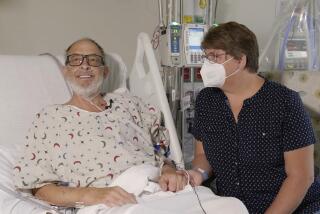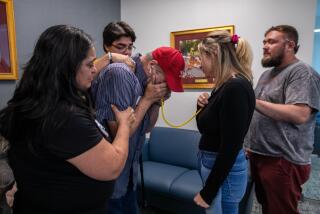Organ Donors May Risk Their Health
Newspapers recently described the death of Albany, N.Y., newspaper reporter Mike Hurewitz at Mount Sinai Hospital in New York City after he donated part of his liver to his brother. Other stories about living organ donors are starting to appear, such as that of Barbara Tarrant, a 69-year-old North Carolina woman who donated a kidney to her mentally retarded son and who wound up paralyzed on her left side and without coherent speech.
What’s going on here?
Consider a full-page New York Times ad for Mount Sinai from December, which boasts that the hospital is “at the forefront of living-donor transplantation” and does more living-donor transplants “than any other hospital in the country.”
Yet though such donors are widely regarded as heroic in the popular media, living-donor transplantations carry real dangers. No one really knows how many people have died from such surgeries, and living-donor transplant centers certainly aren’t going to tell us.
For many decades, a bright ethical line existed in transplant surgery: “First, do no harm.” This meant, among other things, that even to help another, never render a healthy person dead. A kidney transplant from one identical child-twin to the other crossed that line in 1954. Then came all the parents donating parts of livers and lungs to their children.
By 1999, the American Medical News, the American Medical Assn.’s weekly newspaper, mentioned the first “confirmed” although “not officially described” death from adult-to-adult liver donation, and it also guessed that two or three other adults had died from donating parts of their organs to children. No one knows the real figures because no law or regulation requires doctors or hospitals to report them.
Many troubling ethical questions come with transplants. If it becomes the norm, how can a parent not volunteer to donate? Given the heroic mantle wrapped around healthy-donor transplantation, can real informed consent be obtained? Do the enormous costs of such operations (a liver transplant costs, on average, $250,000) and their likely harm to donors justify expansion of the trend?
The answers to these questions need a context, and it is this: If there were no alternative to living-donor transplantation, it might be justified. After all, about 4,000 Americans die every year waiting for organ transplants.
Fortunately, there is another way: We could start paying families for the organs of deceased relatives. More technically, states could allow “rewarded cadaveric donation,” such that families that agreed to donate would get, say, $1,000 toward a funeral. Tens of thousands of usable organs now go to worms and could be used to save lives.
True, there are risks of commercialization, and we certainly don’t want a market for organs. But paying a small stipend would encourage the kind of donation that is already legal for brain-dead patients. And the question is not whether any risk of harm exists from commercialization--it does--but whether such risk justifies the sacrifice of thousands of dying patients.
It doesn’t.






